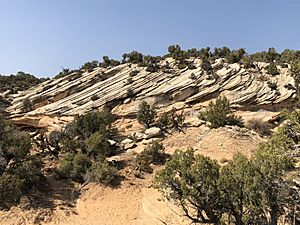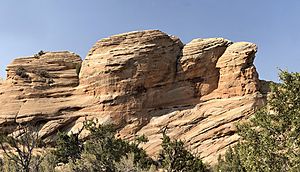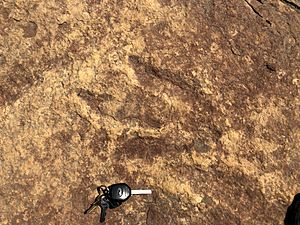Nugget Sandstone facts for kids
Quick facts for kids Nugget SandstoneStratigraphic range: Norian-Toarcian ~220–180Ma |
|
|---|---|
| Type | Geological formation |
| Unit of | Glen Canyon Group |
| Underlies | Carmel Formation |
| Overlies | Chinle Formation |
| Thickness | 200 m (660 ft) |
| Lithology | |
| Primary | Sandstone |
| Other | Mudstone, siltstone |
| Location | |
| Coordinates | 40°24′N 109°18′W / 40.4°N 109.3°W |
| Approximate paleocoordinates | 27°24′N 46°36′W / 27.4°N 46.6°W |
| Region | Colorado, Idaho, Utah |
| Country | |
| Extent | Colorado Plateau |
The Nugget Sandstone is a special rock layer found in the western United States. You can see it in places like Colorado, Idaho, and Utah. This rock formation formed a very long time ago, between the Late Triassic and Early Jurassic periods. That's about 220 to 180 million years ago!
Scientists study the Nugget Sandstone to learn about Earth's past. It's famous because it holds amazing clues about ancient life. These clues include fossil tracks left by theropod dinosaurs and other creatures.
Contents
What is the Nugget Sandstone?
The Nugget Sandstone is mostly made of sandstone. This means it formed from sand that was pressed together over millions of years. It also contains some mudstone and siltstone. These types of rocks tell us about the environment where the sand was deposited.
Scientists believe this area was once a huge desert with giant sand dunes. The way the sand layers are stacked, called "cross-stratification," shows how wind blew the sand around. Sometimes, ancient rivers or lakes might have also been present.
You can often see special lines in the rock called "bounding surfaces." These lines show where wind eroded the top of an old sand dune before a new one formed on top. It's like seeing the ancient desert landscape frozen in time.
Ancient Animals and Their Traces
The Nugget Sandstone is a treasure chest for paleontologists. They have found many different kinds of fossils here. These fossils help us understand what life was like millions of years ago.
Real Fossils: Bones and More
Sometimes, scientists find actual bones or parts of animals. These are called body fossils. In the Nugget Sandstone, they have found remains of:
- Theropods: These were meat-eating dinosaurs, like the famous T-Rex, but much older and smaller.
- Sphenosuchians: These were ancient relatives of crocodiles.
- Drepanosaurids: These were strange reptiles with grasping tails, possibly living in trees.
- Sphenodontians: These are a group of reptiles that include the modern-day tuatara.
One very important discovery is a flying reptile called Caelestiventus.
| Animals Found in the Nugget Sandstone | ||||||
|---|---|---|---|---|---|---|
| Genus | Species | What was found | Cool Facts | Images | ||
| Caelestiventus | C. hanseni | Most of its skull, a full lower jaw, and a finger bone. | This was a type of pterosaur, which was a flying reptile. It's the first clear pterosaur fossil found in North America! | |||
Other fossils found include:
- Rhynchosauroides sp.
- Lepidosauria indet. (This means an unknown type of lizard or snake-like reptile)
Trace Fossils: Footprints and Tracks
Even more common than bones are "trace fossils," also known as ichnofossils. These are not parts of the animal itself, but signs of its activity. Think of them as clues left behind! In the Nugget Sandstone, scientists have found many amazing trace fossils, especially footprints.
These footprints tell us about the size of the animals, how they walked, and even what they might have been doing. For example, some tracks show where a dinosaur walked across a muddy or sandy surface that later turned into rock.
Some of the trace fossils found here include:
- Batrachopus sp.
- Brachychirotherium sp.
- Brasilichnium sp.
- Cochlichnus sp.
- Diplichnites sp.
- Grallator (Eubrontes) (These are often dinosaur footprints!)
- Gwyneddichnium sp.
- Octopodichnus sp.
- Otozoum sp.
- cf. Paleohelcura sp.
- Pterichnus sp.
- Scoyenia sp.
- Treptichnus sp.
- ?Acanthichnus sp.
- ?Apatopus sp.
These tracks give us a peek into the ancient world of the Nugget Sandstone, showing us where dinosaurs and other creatures walked millions of years ago.




